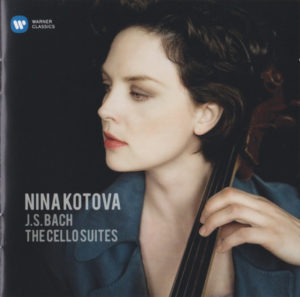
Nina Kotova. Bach Cello suites. Warner Classics. 0825646394111.
Released 2014. Recorded at the Purchase College Performing Arts Recital Hall. No date specified.
Instrument quoted as “the 1679(1673 from other sources) Du Pre Stradivarius cello.”
The cellist.
Nina Kotova is a Russian-American performer who appears to have made her debut age 11, diverted off to modelling then returned to a successful solo performing career, including a recording of her own cello concerto. She looks to have been very well promoted in various magazines, and with various television and radio appearances. The appearance that raised my eyebrows a couple of notches was an interview on the BBC programme hard talk, which is often a forum for interrogation of controversial politicians. Unfortunately, I have been unable to find a recording of that interview.
The recording.
This is a high impact recording in many ways. Firstly, the sound level is very high, necessitating reduction of amplifier controls. Secondly the tone is very brassy, and fulsome in the mid and lower registers. Thirdly, the cello appears to be very closely recorded so there is plenty of breathing but no other annoyances. The acoustic is “lively” with lots of resonance. The recording appears to have taken place in a recital hall. I’m not sure if the acoustics of such a venue are the best for recording without an audience to mop up some of the reverberation. This feature seems to have been capitalised on to produce lingering last notes of a number of the movements which felt unnatural to me. At some points I had an impression of swirling noises in the background which muddied the overall sound at times.
The music.
Cards on the table! To my mind this is a marmite recording, you will either love it or hate it and few will be indifferent.
It has all the features of an excellent recording. Big, bold sound, technical prowess, lyricism, rhythm and pace in the faster movements particularly the Gigues and Gavottes. There is variation in tone on occasion and full on romanticism even with the occasional portamento (slide). However, there is just too much of all the aforementioned. The romance seems exaggerated, the tone sometimes forced and gritty. At times the pace particularly in the sixth Suite threatens to make the faster passages untidy. In the Prelude of this Suite this spoils the wonderful mid section by following with the last third that becomes indistinct at times during the semiquaver passages.
For me, the recipe worked well in the first Suite Gigue, the second Suite Prelude and the Minuets of the second Suite. These latter movements were contrasted hugely the first being almost a heavy metal dance, whilst the second was more sedate! I enjoyed the higher sections in the sixth Suite which demonstrated that Kotova does have a lovely tone in contrast to the full on lower registers which might even have been a feature of equalisation issues in the recording on top of the cello’s natural tone being one of the early, larger Stradivarius Cellos which were reduced in size.
Having listened to this recording I investigated a few videos of the performer and was pleasantly surprised that she appeared to have no flamboyant mannerisms and appears very focussed and serious in her presentation.
Conclusions.
This is possibly one of the most striking renditions of the Suites that I have heard. That may be the key, in that it is increasingly uncommon to hear a Suite played in its entirety on radio or TV. On programmes such as Classic FM it is single movements only. In this scenario, Kotova’s interpretations are likely to make an immediate favourable impression. Perhaps that is the design of this project? For me, listening to whole Suites was rather unsettling.
To balance these comments, I should add that I listened to a variety of more romantic pieces performed by Kotova on Spotify and found them much more easy to enjoy.
Post script.
After an overnight ponder, I was inspired to listen to my recording of the Suites by Casals, specifically the sixth Suite. I was left thinking there were rather more similarities between the two renditions than differences, particularly the emphasis of the contrast between passages in the higher registers and lower registers. Whatever you may think yourself about that comparison, you would have to agree that both performances are highly idiosyncratic!
Charles.
Brief comment from Mark.
I agree with much of the above but feel more strongly about the adverse impact on my listening pleasure. Not a recording I will return to!
Mark.